How Long Does It Take for a Blue Octopus to Kill a Human
Blue Ringed Octopus.
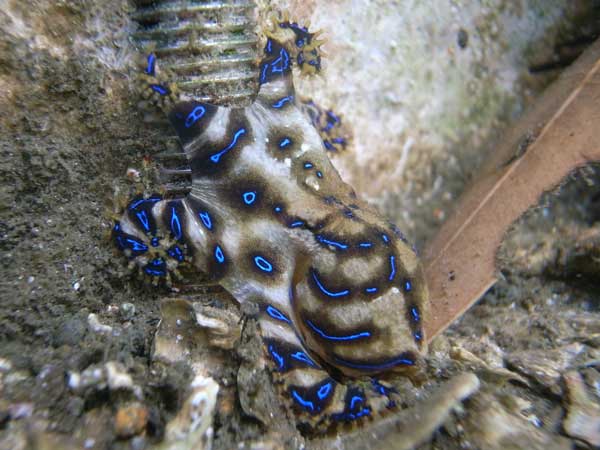
Clever Small And Deadly
The size of a Blue Ringed Octopus is 10 to 20 cm (5 to 8 in). There are four different species of venomous blue-ringed octopuses.
They aren't a giveaway to predators or even to humans, The Octopus is lurking behind his incredible camouflage, armed with one of the most deadly weapons on earth.
The Blue Ringed Octopus carries enough venom to kill several human beings in just a matter of minutes. How many adult humans do you think I can kill?
Despite its modest size, is packed with enough poison to actually kill twenty-six full-grown human beings. Their bites are usually small and painless, and people often do not know they have been poisoned up until the effect starts to kick in.
Article Overview:
-
- Poison
- Anatomy
- Predators
- Reproduction
- Diet/Feeding Habits
- Habitat/Distribution
- Behavior
- Evolution
- Habitat/Distribution
What happens if you get bitten by a blue-ringed octopus?
After 1-2 minutes, the venom paralyzes the victim by blocking the nervous system that controls muscles from transmitting messages.
The target will remain fully conscious, and Then Death usually occurs as a result of lack of oxygen.
The only way to survi ve is to get artificial respiration until help arrives.
The first 4 to 10 hours is the most dangerous.
What Is The Name Of the Poison The Blue Ringed Octopus?
The name of the blue-ringed octopus poison is The Chemical and toxin called Tetrodotoxin, and is produced in its salivary glands live bacteria.
How poison is the Blue Ringed Octopus venom?
Tetrodotoxin is one of the most poisoned chemicals produced by any animal, it is dazzling 1200 times more powerful than cyanide.
Has Anybody Got Killed By A Blue Ringed Octopus?
Two people in Australia and one in Singapore. But Many have come close to death.
California Two-Spot Octopus
Trademark feature
They have the characteristic blue rings around their bodies, even when they change colors to blend into surroundings those bluish identifying marks are there.
They are normally a yellowish coloring but you may not see them in that original color. With the location where they live it can often be a brownish or a cream color that they will portray. That way they can really blend in well to the surroundings. The bluish coloring of them is quite distinct though so you should always be able to determine them from other types of Octopus.

Anatomy Invertebrates = No Bones
The body of the Blue-Ringed Octopus is very impressive. They are very small in size but their anatomy allows them to be very powerful. The body is very flexible due to the fact that it don't have a skeleton. They are able to move very quickly through the water as well. The body is very small with an overall length of about 8 inches. However, the arms can spread very wide when they are trying to capture prey.
They are usually seen swimming in the water instead of crawling. They do lay sideways though which is why it is so easy for someone to end up stepping on them in the water. What is unique is that such a small creature can have such a powerful amount of venom in their bodies. It is a huge mystery when it comes to the design of their anatomy.
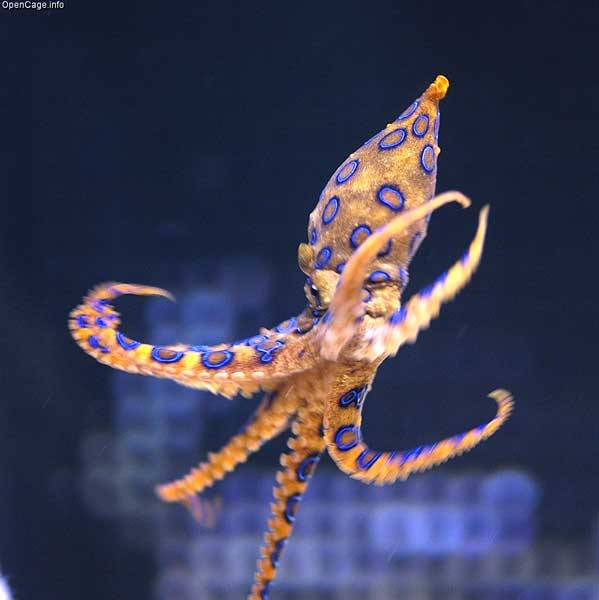
Evolution
There are experts out there with an explanation for that though. They believe that this powerful venom is the result of evolution. It has made it a powerful source to be reckoned with in the water. They believe that the venom has only continued to get stronger over time.
Evolution is a huge issue with any animal, it is a way to see where they once were and how that has allowed them to be shaped today. Yet there isn't very much to know about the Blue-Ringed Octopus. It is really a mystery about how they came to be about. They have a body that is very different from other types of creatures that live in the water.
They have proven high levels of intelligence as well as the ability to adapt to their environment. It is believed that the ink sac they have is one part of evolution. It offers the Octopus a way of escaping predators so that they can survive.
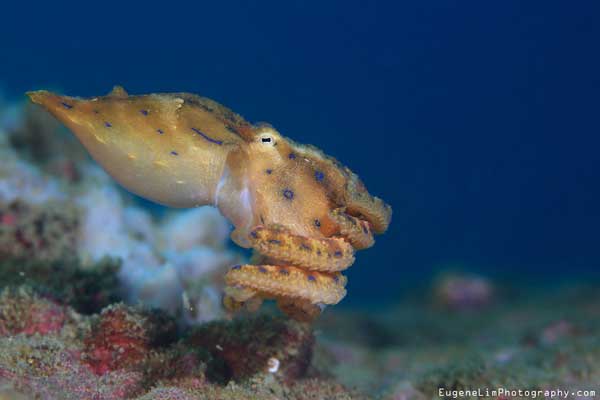
This is one of the most aggressive species of Octopus in the world. They aren't as likely to run and hide as they normally would. They also will fight with other Octopus in the area to be able to keep their food and shelter to themselves. With most other species they simply ignore each other but that isn't the case here.
The venom that the Blue-Ringed Octopus is able to release is a huge concern for humans. In fact, it is the only type that is able to kill humans if they get bitten by one of these octopuses. That is a prime reason why many people avoid bodies of water where they happen to live. They worry about stepping on one and it biting in retaliation.
How can I see If The Blue Ringed Octopus is aggressive?
Answer: It will give you a fair warning by Flashing Bright Blue Rings.

Where do I find the Blue Ringed Octopus? – Habitat/Distribution
Indian and Pacific Oceans (Shallow waters) are the Blue-ringed octopus's habitats.
This type of Octopus isn't as widely distributed out there as many others. They are known to reside in certain areas of the Pacific Ocean. The largest groups are in the waters around Japan and Australia. Determining the exact locations of them there can be difficult as they move often. They continue to find new homes every couple of weeks for safety.
Read Or Listen To – Types of Octopuses
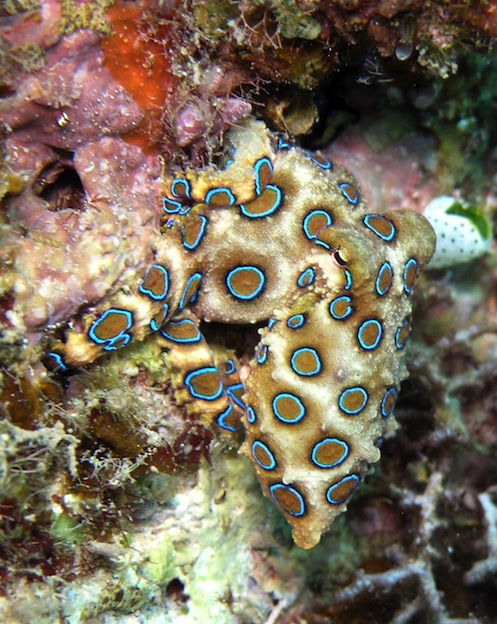
Diet/Feeding Habits
They generally are able to find plenty to eat due to the diverse nature of their diet. They hunt at night and thanks to their excellent vision they are able to find food with no trouble at all. They consume shrimp, fish, and hermit crabs. They are successful hunters due to their speed. They are able to place venom into the body of their prey in very little time.
This process is one that completely paralyzes the prey. This gives the Blue-Ringed Octopus plenty of time to come in and to use its powerful beak to break the shells. Then it can consume the food source inside of it. They are also known for their cannibal behaviors. Yet it is important to point out that they consume each other for territorial rights and not due to the urge to find food.
Reproduction
As I mentioned they are very isolated due to the aggressive nature they portray. They do change that tune though when they are ready to take part in mating. The males and females will stay in the same area for a couple of days in order to for the mating to occur as many times as possible during that period of time.
The males love the act of mating, and so the females have to push them away after a couple of days. They will be persistent which can result in some bitter battles taking place. The females are ready by then to be left alone and they will do whatever they have to in order to get that message conveyed to the male.
Once they are done with the mating process they will go their separate ways. The females will have about 50 eggs that develop in their bodies. They will fertilize them with the sperm they gathered from the male. Once she has successfully done that she will place them securely under her arms. The suctioning power will keep them in place until they are ready to hatch.
Both the males and the females have a very short life span. The males will die soon after mating is finished. This can be within a couple of days or they may have a few weeks of life left. For the females, once she has those eggs to care for her own needs are no longer a priority. She will begin shutting down too with her death being very close to the hatching of her eggs. The average life span for this Octopus is 1 ½ year.
Predators
There are quite a few different predators out there that the Blue – Ringed Octopus has to deal with. They include whales, eels, and birds. These types of predators are able to get to them very quickly and with the element of surprise on their side. There are times though when these predators become the prey due to the Octopus getting a good bite. That will immobilize them. The Octopus can either feed or it can swim away.
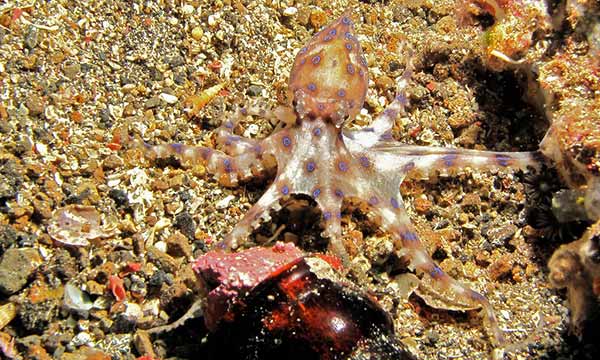
Due to the very danger of these octopuses, they are also heavily hunted by humans. They figure it is best to get rid of them from the water than to live in fear of them. Most people don't seem to think there is anything wrong with hunting them so that people can be safer in the water.
Please leave a comment or ask any questions. You are also welcome to share a story, experience or a link to something interesting about octopuses.
Three hearts, a massive brain, and blue blood, they navigate unlike anything else. The earliest octopus fossil is Pohlsepia, which swam the oceans 296 million years ago.
Learn More – Wikipedia.org –Blue-ringed octopus
Source: https://octopusworlds.com/blue-ringed-octopus/
0 Response to "How Long Does It Take for a Blue Octopus to Kill a Human"
Post a Comment